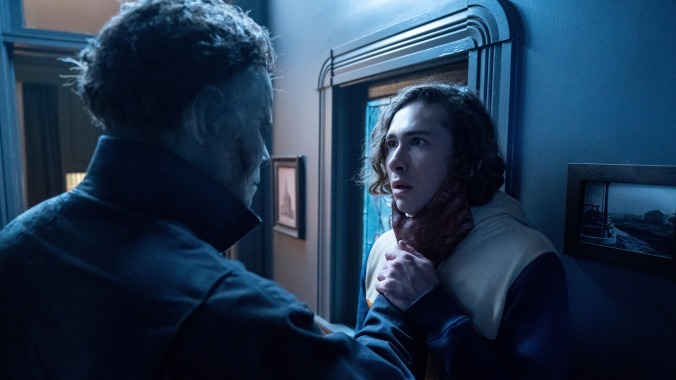Halloween Kills can’t help but shoot (and stab and bludgeon) itself in the foot
David Gordon Green’s latest Halloween sequel chokes on its own bloody, convoluted vomit


John Carpenter’s Halloween is masterful in its simplicity. The premise is minimal, the villain elemental, the storytelling economical. Not a single frame is wasted, and as a result, the film retains its power to terrify 43 years in. But Halloween Kills, the second sequel in a rebooted timeline that ignores all the Halloweens after Carpenter’s original, can’t help but overcomplicate that which should be straightforward.
It tries, briefly: After an extended prologue set in 1978 that finds the one angle on the original story that hasn’t been done to death (don’t worry, the movie will finish it off by the end), director David Gordon Green places us back where his 2018 Halloween left off with brisk, efficient scene-setting cuts. Soon, however, he succumbs to the temptation to try to make these functional edits funny as well. And that’s where this overstuffed, overwrought, insincere, borderline incomprehensible movie begins to go wrong.
The line around the 2018 Halloween press tour was that the film was really “about” trauma, and that Laurie Strode (Jamie Lee Curtis) and her lifelong mission to destroy Michael Myers was a love letter to survivors. If this argument was ever earnest—and this film calls that into question—Halloween Kills drowns it in what, if you peel back a few layers of moralizing and nostalgia bait, is a savage bloodbath à la the 1981 Halloween II. The problem isn’t that Halloween Kills is about nothing more than brutal nihilism; that’s a perfectly acceptable thing for a horror movie to be. It’s that it tries to be about so many things on top of brutal nihilism that it loses its grip early on.
Here, Laurie and her family plumbing the depths of their sadness is but one note in a discordant symphony, one where all the instruments are playing at once. The movie is trying to do so much, both thematically and narratively, that Laurie, her daughter, Karen (Judy Greer), and her granddaughter, Allyson (Andi Matichak), end up becoming minor characters in their own story. Green and company might have meant well in having scenes where Karen shakes and sobs with grief, or Laurie seizes up in emotional agony when she discovers that, once again, she has failed to kill the boogeyman. But the tonal shifts in this movie swing so wildly and imprecisely that the actors’ wrenching performances end up coming across as phony—or, worse, as trauma porn.
As far as what works, co-writer Danny McBride once again acquits himself well: There are some genuinely funny one-liners in Halloween Kills. Julian (Jibrail Nantambu), the scene-stealing little kid from Halloween, reappears briefly, and two more minor characters are re-introduced and fleshed out in charming, humorous fashion. We also get a handful of endearing new characters, like the squabbling, elderly husband and wife who have the bad luck of living down the street from Laurie. We only see those two for a few moments, but spend a little more time with a loving gay couple who call each other “Big John” (Scott MacArthur) and “Little John” (Michael McDonald). The Johns also inject a bit of meta commentary into the film, as they’ve bought Michael’s childhood home and love to scare trick-or-treaters with the story of the masked madman who killed his sister when he was just 6 years old.
Their hubris will be punished, of course, in merciless, blood-soaked fashion. Halloween Kills also delivers in terms of gore—if you’re coming to this movie to see splatter, then you’re going to get it. The Michael in this film is especially sadistic, even for a Halloween sequel. He’s fond of stabbing, smashing, bludgeoning, and slicing necks and faces, and the camera lingers on the characters as their eyes go wide with fear and they choke to death on their own blood. The body count in this film is somewhere north of 20 people, and the dialogue works in an exact number of the dead whenever possible. But Halloween Kills can’t just leave the viewer to the pleasure of fictional bloodlust, randomly emphasizing the gravity of some deaths while playing others for laughs. Life is cheap in Halloween Kills—unless it’s precious.
One of the messier and more faithless subplots in the movie brings back the child survivors from the original Halloween. This group of damaged fortysomethings—featuring Kyle Richards as Lindsey and Nancy Stephens as Marion, a nurse from the first film—is led by little Tommy Wallace (Anthony Michael Hall), now big and tough and slinging a baseball bat over one shoulder. It’s sweet when Tommy promises Laurie that, just as she protected him 40 years ago, he will protect her.
And the image of a drunken mob pouring out of a bar with vengeance on its mind is compelling—if something we’ve seen before, in one of those later Halloween sequels Green’s series likes to pretend didn’t happen. (Here, again, Halloween Kills tries to have it both ways, lifting plot points and inserting Easter eggs from the same movies it wants to retcon out of existence.) But with the introduction of Chekov’s escaped mental patient soon thereafter, it’s obvious that Halloween Kills is trying to make a point about vigilantism—one that it convolutes and contradicts up to a gigantic whiff of an attempt at critiquing police corruption.
As the movie plunges deeper into a death spiral that’s both literal and narrative, you begin to realize that Michael Myers is the protagonist of this movie, not Laurie Strode. It’s not about mob justice or intergenerational trauma or any of the other bullshit it’s tossed in its own path along the way. It’s about cheering when Michael stabs a guy in the heart, reveling in a brief, primal moment of catharsis as we celebrate the fact that these people are dead and we are alive. That acknowledgement is the first—and only—honest thing about the film.